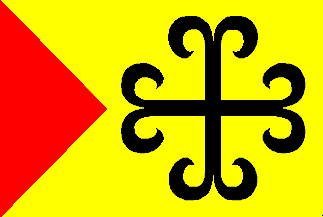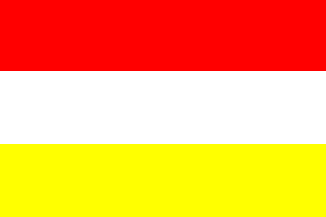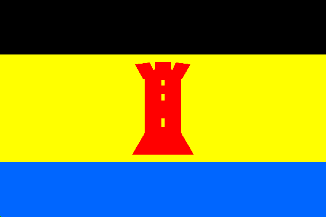 Shipmate Flagchart : http://www.flagchart.net
Shipmate Flagchart : http://www.flagchart.net
adoped 1982

Last modified: 2011-03-26 by andrew weeks
Keywords: sittard | geleen |
Links: FOTW homepage |
search |
disclaimer and copyright |
write us |
mirrors
 Shipmate Flagchart : http://www.flagchart.net
Shipmate Flagchart : http://www.flagchart.net
adoped 1982
 Shipmate Flagchart : http://www.flagchart.net
Shipmate Flagchart : http://www.flagchart.net
Geleen is c. 20 km north of Maastricht, one of the old mining centers
in the region. After the mines were closed the chemical industries of DSM
offered employment.
The flag was unofficially used until it was officially adopted in (?),
derived from the Coat of Arms.
Jarig Bakker, 26 November 1999
Geleen is the result of a merger of 3 villages (Oud-Geleen, Lutterade
and Krawinkel), after 1920 these villages started growing in towards each
other, and when the State Mine Maurits opened (in 1928) this accelerated.
After the State Mine closed, DSM (Dutch State Mines) developed a very large
chemical complex here. The municipal borders were adjusted in 1982, so
that all DSM property was within the municipal borders.
Franc Van Diest, 25 February 2001
The former SBB (Stikstof Bindings Bedrijf) changed its name to DSM,
but existed long before the closure of the mines - it expanded immensely
till the end of the 1960's. If the chemical company had been founded after
the closure of the mines I wonder where my dad had been working all that
time! He laboured in naphta-crackers, phenol- and hydrochloric factories.
After the expansion "talking poles" were put around the factories,
which ought to warn the population in the case of a calamity.
C.W.De Meyer-Honneff, 30 Jan 2004
 Shipmate Flagchart : http://www.flagchart.net
Shipmate Flagchart : http://www.flagchart.net
Born is northwest of Sittard on the Maas river. It was built around
the castle of the count de Noidans (built 1647-1666), where according to
tradition one can find the throne of king Zwentibold or Sanderbout. Zwentibold
was the illegal son of Arnulf (c. 850-900), king of Germany, who spent
some time in Born before he was elected king of Lorraine (895-900). He
died in the battle of Susteren (13-8-900).
The colors of the flag are the Gelderland
colors upside-down; Born used to be partly of Gulik, partly of Gelre.
Jarig Bakker, 23 November 1999
![[Munstergeleen flag]](../images/n/nl-li_mg.gif) Shipmate Flagchart : http://www.flagchart.net
Shipmate Flagchart : http://www.flagchart.net
Flagdescription: Two equally wide horizontal stripes of blue and red;
on the blue stripe charged with a white sword; on the red stripe with white
plyers; and a yellow hoist-triangle with a black snakehead-cross.
This flag was adopted by municipal resolution on 17 Apr 1962. It is
derived from the municipal arms; the white sword symbolizes Saint Pancratius,
and the white plyers Saint Apollonia. The snakehead-cross is taken from
the Sittard Coat of Arms.
Source: Sierksma's Nederlands Vlaggenboek [sie62].